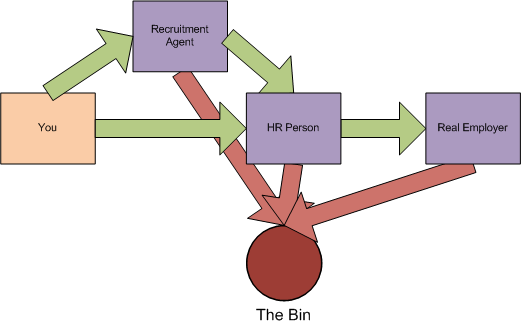A CV has to be carefully designed, but if it’s not designed for the correct purpose it’s no good. This is the problem with a lot of CVs – clearly a lot of care and attention has gone into them but they miss the point.
There are hundreds, probably thousands of articles out there on how to format a CV well so there’s no point in me going down that road. I’m going to approach it differently, I believe that in order to write a good curriculum vitae (or resume), you need to understand the process that it’s going to go through. Then it all becomes much, much easier.
The first thing we need to get clear is that unless you’re applying for a very niche market, your prospective employer is going to be heavily oversubscribed with applicants, many of whom have no prospect of getting the job. The net result is that it’s a waste of time for the employer to pass all the CVs to your prospective boss for consideration – they could easily outnumber the positions available by 100 to 1 and 75% or more could be rubbish. The first “paper sort” is usually done by someone from Human Resources who may have no knowledge of the job in question, merely the job description.
The first task of your CV is to get past the HR person. Thankfully this is relatively simple, but many people do it badly or even fail here when they could actually do the job.
You must make sure that you cover the basic requirements for the job and that this jumps out from the page. Don’t assume that anyone knows that experience of one technology / methodology / system includes or implies experience of another. I know someone who failed to get an interview because she listed a plethora of technical skills but failed to mention the phrase “computer literate” which was an essential for the role.
Assume the HR person has no technical knowledge and make sure the keywords on your CV match the keywords on the job specification as closely as you can justify. Doing this with qualifications, technical skills and experience is relatively easy. Some have to be worked in more carefully such as “initiative”, try to get them in though as if it’s on the job specification the HR person will be looking for it.
It’s really, really important that you get this right. Having a CV full of really great technical stuff is going to do you no good if you can’t get it past the HR people.

Your CV then goes to your prospective boss, or at least someone in the department. This department is recruiting so the chances are that they’re busy, meaning that time is of the essence. HR departments tend to err on the side of the false positive so the first sort is usually to get rid of people who could not in fact do the job. This is done quickly, so the clearer your CV the better. Don’t go over-the-top trying to list every piece of technology and every skill you can lay some kind of claim to in an attempt to impress your new boss. If anything that will make you look worse. Concentrate on providing evidence for what you’ve asserted. For instance, if you claim in the highlights that you’ve got 3 years of C# experience but you don’t list any previous positions involving C# development, it’s not going to look good.
Now you’re on the short-list. The person calling the shots is now probably looking at the set of CVs and thinking about either pulling out a few of the best or eliminating some of the worst. Fortunately for the good CV writer it’s not a level playing field. If your CV is easy to read your propensity to stay out of the bin will be greater. If you have a wordy CV that’s hard to read it may end up in the bin on those grounds alone. Similarly mistakes or inconsistencies on your CV can land you in the bin. Technical positions require the ability to communicate clearly and effectively and to show good attention to detail. If your CV doesn’t demonstrate these traits then it’s a good excuse for it to be thrown in the bin.
When I explain this to people I get a few slightly surprised reactions at this point – do employers really throw CVs in the bin simply because they’re too long or they don’t like the style? It can happen. If you’re comparing two CVs that seem to show individuals of similar suitability for the job but you can only interview one, you have to make a decision somehow. The quality of the CV can reveal a lot about the personality and attitude of the person.
Another piece of very useful inside information is that the actual goal of the recruitment is not necessarily to employ the person that matches the job description best. It’s to employ someone who’s going to be good at the job and is going to work well with the existing people in the team. Your CV should demonstrate some personality, there is width for creativity. Don’t go mad with crazy fonts, that will be counter-productive, but try to introduce a hint of your personality into it.
Something that I think very little attention is paid to and that can land your CV in the bin is the inclusion of material that reflects negatively on the applicant. Think about what the company is asking for and if there’s anything on your CV that contradicts that then remove it or if you can’t, play it down. It’s worth mentioning that opinions are almost always a bad idea. Their negative points exceed the positive. If you’re going to link a blog, profile or web site then think carefully about its contents and how it reflects on you. If you express a lot of left wing sentiment on your blog for instance, your prospective new employer may not appreciate this.
Finally, although many disagree apparently, I like to see a “Hobbies and Interests” section. It should be every brief, though, perhaps as terse as just a list of 5 words. If for nothing else, it’s useful to provide the employer with an ice-breaker in the interview.
If you take nothing else away from this article, remember these two things;
- You must demonstrate that you meet the job specification
- Your CV must be clear and easily read by a non-technical HR person and a hassled potential new boss
Happy hunting!

Great advice – thanks for publishing.
And yes, prospective employers do bin CVs that are difficult to read. I was recently reviewing applicants for a number of roles and, even though we discussed every CV before rejecting/inviting to interview, some were easier to find the details we were looking for than others.
In one case, there was a CV that was (I think) 13 pages long and written in 8pt Times New Roman. The text was so dense on the page that, from a quick scan, I really couldn’t find the evidence I was looking for that this person could do the job (incidentally, written and verbal communication would have been key to the role). I’m pretty sure that candidate was rejected.